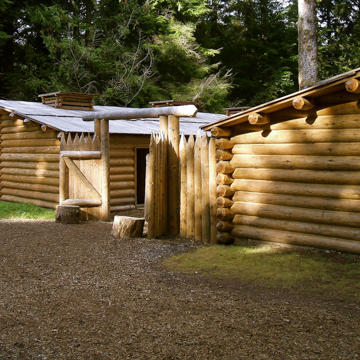Fort Clatsop illustrates the challenges of wooden construction on the coast of Oregon, where coastal forests of spruce, hemlock, and fir provide ample building material, but the wet climate limits the lifespan of the wood buildings. Established in the winter of 1805–1806 as the final encampment of the Lewis and Clark Expedition, Fort Clatsop was relinquished to the local Clatsop people, and the log structure soon rotted away, leaving no discernable trace. Log houses were fairly numerous in Oregon, though virtually all date from the mid-nineteenth century, when they were built of necessity, through the early part of the twentieth century, when they were built for romantic nostalgia.
In 1955, the State of Oregon decided to build a reproduction of the long-vanished fort in celebration of the sesquicentennial of the Lewis and Clark Expedition. Only general indications of the location of the fort were given in the journals of Lewis, Clark, and a few others in the Corps of Discovery, as Lewis styled the exploratory group. On the inside of the leather cover of his journal, Lewis made a simple line drawing of the plan of the 50-square-foot fort, showing two ranges of rooms for the captains of the Corps, the other explorers as a group, and storage rooms for supplies, positioned on either side of a small internal yard. The two ends of the yard were then closed by palisaded walls that connected the parallel ranks of rooms. The wood shake shed roofs over the two rows of rooms were pitched inward so that rainwater could be collected in barrels. The fort was rebuilt following Lewis’s written description and diagram in what was believed to be the general vicinity of the original encampment. In 1958, it was declared a National Memorial.
Through the end of the twentieth century, the reconstructed Fort Clatsop was populated with volunteers in period dress, who demonstrated for visitors an interpretation of daily life of both the American explorers, and, by the end of the century, of the native Clatsop people as well. These reenactments included fires maintained in the clay daub-lined fireplaces and chimneys illustrating how the rooms were heated during the long months of the winter of 1804–1805, when Corps of Discovery journal writers complained of the incessant rain and unvarying rations of boiled elk meat. At the end of each day, the demonstration fires were extinguished for the night when the caretakers retired to their modern residences in the neighboring community. In 2005, enough embers remained one evening that the fire rekindled and ignited the structure. By the time firefighters arrived, the replica Fort Clatsop was destroyed.
With the bicentennial of Lewis and Clark’s original encampment and renewed interest in the site following the fire, Fort Clatsop was rebuilt once again. The reconstruction benefitted from an additional fifty years of historical research. As a result, the door hinges were created from squares of leather rather than metal, and the ends of the new logs used to rebuild the fort were left as shaped by the axe rather than being squared with a saw.
Fort Clatsop is now part of the Lewis and Clark National Historical Park, designated in 2004, as one of several sites in Oregon and Washington related to the Lewis and Clark Expedition.
References
Dmytryshyn, Basil, E.A.P. Crownhart-Vaughan, Thomas Vaughan. The Russian American Colonies 1789–1867. Portland: Oregon Historical Society Press, 1989.

